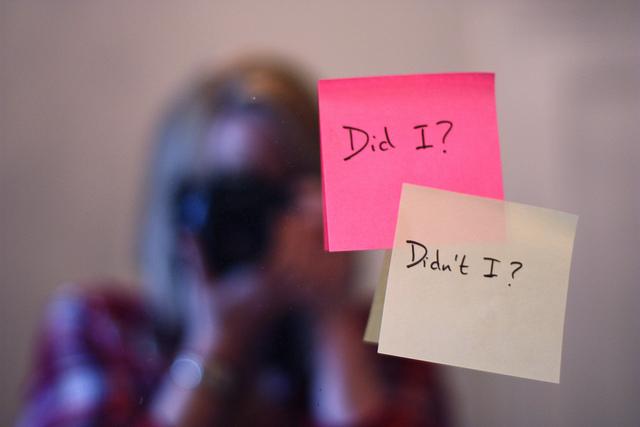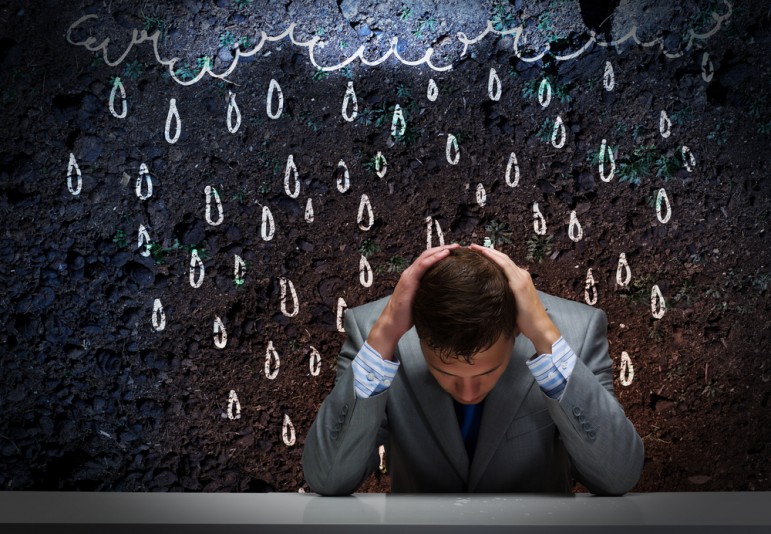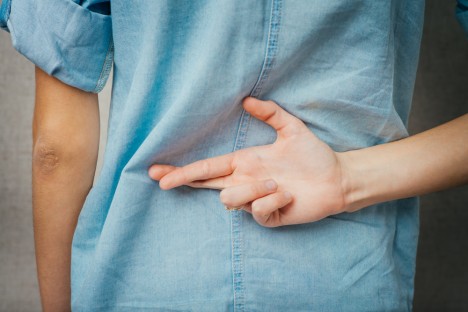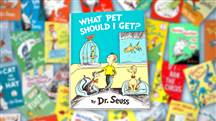To this day, Katie Koppel, a 23-year-old recent college graduate who lives in Boston, still remembers the exact moment she first pulled out her hair. She was a bored 7-year-old, sitting in front of the television. Mindlessly, her fingers wandered to her face and landed on her eyebrows.
“I pulled out half my eyebrow in a couple of hours,” Koppel recalls. “I just remember looking into the mirror and seeing what I had done, and not understanding what had just happened. I felt this tremendous sense of fear.”
Koppel’s pediatrician thought her hair loss might be caused by lupus. Her parents were stymied. Nobody thought to ask Koppel – who by then had begun shutting herself in closets for hours at a time, yanking at her face and scalp with swollen fingers – if she was pulling her hair out herself.
Eventually, Koppel’s mother did a Google search for “unusual forms of hair loss.” She discovered a clinical term for her daughter’s condition: trichotillomania.
Trichotillomania is a condition in which individuals feel the compulsive urge to tug out their body hair. Leg hair, scalp hair, arm hair and armpit hair are all fair game, as is facial hair, eyelashes, chest and pubic hair. However, Koppel and her mother would soon learn that trichotillomania falls under an even broader umbrella of little-understood disorders called body-focused repetitive behavior, or BFRBs. These are behaviors that involve compulsively damaging one’s physical appearance – picking at skin, pulling hair, biting nails and even chewing one’s lips or the inside of the cheeks.
But wait – doesn’t everyone pull their hair or pick their skin from time to time?
According to Dr. Nancy Keuthen, a professor of psychology at Harvard Medical School and co-director of the Trichotillomania Clinic at Massachusetts General Hospital, individuals with BFRBs “have tried repeatedly to decrease or stop. [Their behaviors] cause distress and impairment in functioning,” she says. “All of us do some skin picking or hair pulling, whether you’re going to admit it or not, but the people who come in for treatment are the people who are seeing significant tissue damage or hair loss.”
About 1 to 3 percent of the population is thought to have trichotillomania, and about 1 to 5 percent is thought to have a skin picking condition known as excoriation disorder. The people who have this clinical level of the diagnosis, Keuthen says, will often start picking or pulling around puberty – although they can also start earlier or later in life. Both men and women struggle with BFRBs, although women are more likely to seek treatment.
Patients with BFRBs might spend an hour or more a day picking, pulling, biting or thinking about it. They’ll constantly try to manage their urges – which might negatively affect their relationships, friendships, family functioning and focus at school or work.
There are also medical and cosmetic concerns. Those who pick at their skin might experience infections and scarring. Individuals who pull out their hair might find it difficult to grow back. In rare and extreme cases, people can pick down to the muscle or dig away at their nose so much that their septum collapses.
And, of course, like many psychological conditions, trichotillomania, excoriation disorder and other related behaviors are accompanied by stigma.
BFRBs are “disorders of isolation and of shame,” says Koppel, who wears a wig to hide her hair loss. “I think in a lot of ways that’s more damaging than any more physical or medical consequences could ever be. Every single person I know with trichotillomania has, at one point, felt like they were the only one who did this. They didn’t know it had a name, they didn’t know it was diagnosable. And people were reinforcing that shame by telling them [they] could stop if they wanted to.”
Men with trichotillomania often escape scrutiny by shaving their heads or beards. With women, who tend to have longer hair, it’s a little harder to hide. And those with excoriation disorders will often pick at areas covered by clothing or wear garments to conceal their marks.
So why do people pick and pull? Doctors are still trying to figure that out. Trichotillomania and excoriation disorder are both listed in the Diagnostic and Statistical Manual of Mental Disorders; both are considered obsessive-compulsive spectrum disorders, though they’re unique from OCD. (Nail biting, lip chewing, nose picking and other behaviors aren’t yet listed; they aren’t as often reported, nor are they as widely studied.)
“OCD is really all anxiety-driven,” says Carol Mathews, a professor of psychiatry at the University of Florida. “You feel a sense of relief when you’ve acted on your compulsion, but you don’t feel a reward. With hair pulling, you feel a sense of relief, a sense of reward, if you got the right hair or you got that scab.”
Mathews adds that OCD is usually accompanied by obsessions – fears of contamination, or a thought that you might harm someone. Compulsions are in direct response to those thoughts. But rather than being triggered by thought, hair pulling and skin picking are driven by urges. “It’s a very physical act,” Mathews says. “There are mental compulsions that you can have with OCD, but it doesn’t have to be a physical compulsion.”
BFRBs feel different for everyone. Some people feel an increased sense of tension or anxiety before they pick or pull, and a feeling of relief after. Yet others pick or pull – almost in an absent-minded manner – when they’re understimulated or bored. And many individuals engage in both hair pulling and picking; Keuthen says that up to half of people with trichotillomania also have excoriation disorder. “They’re kind of kissing cousins,” she says.
Angela Hartlin, a 29-year-old from Dartmouth, Nova Scotia, who has excoriation disorder, finds she’s more prone to picking while dealing with stress.
Her skin picking “was personally driven by anxiety,” Hartlin says, who once picked at her skin for hours a day and has experienced both infections and scarring. “I found it calming. So calming down the anxiety is something I have to do as part of my self-care routine. You have to know your own specific triggers and counter them.”
Hartlin eventually recognized her triggers. But it took help from a professional therapist, who started working with Hartlin after she appeared on a television show to talk about her experience with excoriation disorder.
For years, Hartlin couldn’t find help. Both Hartlin and Koppel faced a common problem that many patients with BFRBs experience – a difficulty finding a medical provider who understands their conditions. Many physicians have little clinical understanding of BFRBs and aren’t trained to treat them. Or they’ll mistakenly diagnose excoriation disorder or trichotillomania as an unrelated skin or psychological disorder.
There are experts out there who treat BFRBs. But if you have a BFRB and don’t live near a major hospital, your best bet is to seek a therapist who specializes in cognitive behavioral therapy, says Dr. Jon Grant, a professor of psychiatry at the University of Chicago. They should be well versed in these behaviors and can hopefully tailor their approach to fit your needs.
Antidepressant medications like SSRIs, or selective serotonin reuptake inhibitors, are often prescribed for individuals with BFRBs. But although they might help with anxiety and depression – which, in turn, might alleviate skin picking or hair pulling – Grant says they show little efficacy for treating conditions like trichotillomania and excoriation disorder. However, studies have indicated that a pharmaceutical drug and nutritional supplement called N-acetyl cysteine might reduce patients’ urges to pull or pick.
Even then, treatment is highly individualized for each patient. Some people might respond to cognitive behavioral therapy, which teaches patients to recognize their thoughts and behaviors and change them. Yet others might not be motivated enough to fully engage in a series of sessions. N-acetyl cysteine might yield improvements in one individual, but not another. Bottom line? What works for you might not work for someone else – and vice versa. For instance, Koppel has not found much success with cognitive behavioral therapy, but she did once stop pulling for six months after trying hypnotherapy. And Hartlin didn’t notice much of a difference with N-acetyl cysteine, but she greatly benefited from therapy.
Is remission possible? Experts and patients alike agree it is – although “remission” might not necessarily mean that you’ll never pick or pull again. Some people are able to stop completely. But you shouldn’t be too hard on yourself if you occasionally find your hand straying toward your face or scalp, Grant says.
Hartlin agrees. “Recovery is possible, but you need to accept yourself and where you’re at with picking or pulling. Loving who you are will enhance your life,” Hartlin says. “I’m in a state of recovery now where I … still have urges, but I can emotionally work through them.”
Hartlin still occasionally finds herself picking – but after many years, she says she’s finally able to wear shorts for the first time. She also finds it rewarding to spread awareness of BFRBs; she’s formed support groups, and her memoir, “Forever Marked: A Dermatillomania Diary,” recounts her years of struggle.
And Koppel – who recently authored her own memoir – found her greatest source of solace through the Trichotillomania Learning Center, which was founded in 1991 to provide advocacy, awareness and support for individuals with trichotillomania. Since then, it has expanded to include those with other BFRBs. While Koppel isn’t in “remission” per se, she is actively seeking treatment. Most importantly, she’s no longer ashamed.
“What I really attribute my emotional healing to is the Trichotillomania Learning Center’s conferences,” Koppel says. “I finally realized for the first time that I wasn’t alone. It’s one thing to read an article on the Internet, but another to be surrounded by people in a room who are going through the same experiences you are. That really drove things home in a way nothing else could.”






 Curzan Family
Curzan Family
 Curzan Family
Curzan Family
 Roberto Farren
Roberto Farren

 Sponsored Content
Sponsored Content Sponsored Content
Sponsored Content Sponsored Content
Sponsored Content Sponsored Content
Sponsored Content